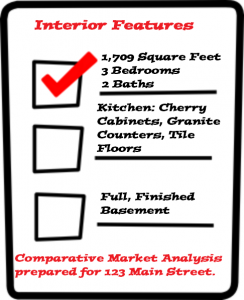What is a Comparative Market Analysis (CMA) in Real Estate?
Have questions about buying or selling a home?
Ask Now!What Should A Quality Market Analysis Include In Real Estate?
Comparable Market Analysis, also known as a “CMA,” is an analysis of recently sold homes (“comparables”), preferably sold within the past 6-12 months, that helps establish a price range for a home which is normally completed by a real estate professional. A common question that sellers and buyers alike ask is, “what is a comparative market analysis and what is the purpose?”
The purpose of a CMA is to help take the guess-work out of what price a home will likely sell for. Additionally, a CMA can help eliminate bank appraisal problems once a buyer and seller agree to a price as the appraised value should be equal to or more than a real estate professionals suggested listing price. There are however no methods that exist that can predict with 100% accuracy what a home will sell for.
A CMA that is completed by a local real estate expert, however, should be very close to a homes final sale price. There are many “pieces to the puzzle” that a real estate agent takes into consideration when completing a CMA to help determine a list price for a home and help predict a probable sale price.

The interior features of a home should be considered by a real estate professional when performing a CMA.
Interior Features
Every home has different features. When performing a CMA a real estate professional will take into consideration many interior features.
- Square Footage: The total square footage of a home plays a large role in a CMA. A real estate agent should compare homes that are very similar in square footage (within 200-300 square feet is best). The square footage of a home that is much smaller or larger, should be adjusted in a CMA. Typically only heated areas can be counted in the square footage of a home.
- Number of Bedrooms: The total number of bedrooms is an important piece of determining the value of a home. If a home has 3 bedrooms and all of the recently sold comparable homes have 4 or more bedrooms, a real estate agent should make an adjustment on the subject properties value.
- Bathrooms: Just like the total number of bedrooms, the total number of bathrooms is an important interior feature of a home. An adjustment should be made within the CMA if a home has 1 less full bath then all of the comparable properties. In addition to the total number of bathrooms in a home, the condition of a bathroom is also an important piece of a CMA. A home that has bathrooms that have been renovated in the past few years should have a higher value than a home that has bathrooms with 1960’s decor.
- Kitchen: A homes kitchen will often sell a home. There are many features within a kitchen that impact a CMA. The type of cabinets (Cherry, Oak, Maple, Etc…), type of counter tops (Granite, Quartz, Corian, Etc…), type of back splash, and type of appliances are just a few. When completing a CMA a real estate agent needs to weigh the condition of the kitchen when comparing the subject property to recent comparable sales.
- Basement Type: There are many cities, towns, or villages where the homes do not have basements and are built on concrete slabs (primarily in the southern United States). In areas where homes do have basements, this is an important feature when determining value. There are many different types of basements, full basements, partial basements, crawl space basements, full finished basements, partially finished basements, and walkout basements. A home that has a fully finished basement should have a higher value than a home that is built on a slab or an unfinished basement. In some cases, walkout basements and homes with means of egress from the basement, can be counted in the square footage of a home.
- Flooring: Believe it or not, the type of flooring a home has will impact the value. There are many different types of flooring. Linoleum, hardwood, ceramic tile, and laminate are just a few that are noteworthy. A home with a high-end ceramic tiled kitchen floor should have a higher value than a comparable home that has linoleum flooring in a kitchen. Wondering what type of flooring would give the best return on investment (ROI) when the time to sell comes? Check out Debbie Gartner’s, “The Flooring Girl’s,” article discussing the best type of flooring for ROI when selling a home.
Exterior Features
Just like every home has many interior features, every home has many exterior features. These exterior features should have an impact on the value a real estate agent determines within their CMA.
- Siding: The type of siding from one home to another can make a difference in determining value. A home with low maintenance vinyl siding will typically carry more value than a home with cedar or wood siding, due to the maintenance involved.
- Windows: The type of windows in a home should be important to a real estate agent when completing a CMA. Windows are important to a home’s energy efficiency as well as it’s safety and often important to a prospective buyer. When completing a CMA, a real estate professional should consider a home that has newer vinyl thermopane windows to have more value than a home with original wood storm windows.
- Roof: The roof of a home has one of the highest replacement costs. The year a roof was replaced and whether is was a complete tear-off or not, should be important to a real estate agent completing a CMA. A home with a brand new tear-off roof is going to have a higher value than a home that has a 20-year-old roof that will need a total tear-off. If a seller is unsure of a roof age, an experienced real estate agent should be able to get a good “ballpark” on the roofs age. Check out Bill Gassett’s article, “How to Tell If You Need a New Roof,” for some excellent tips on determining the condition of a roof.
- Fencing: Whether a home has chain link fence, stockade fence, invisible fence, is partially fenced, or no fencing, should be taken into consideration when completing a CMA.
- Parking/Garage: The presence of a garage and/or driveway is a very important exterior feature to many potential buyers. Many buyers won’t consider looking at a home with no garage and/or driveway. Within a CMA, there should be an adjustment made for the number of garage spaces and also whether a home has a driveway or not. For example, a home with a 2.5 car garage has more value than a recent comparable sale that has a 1.0 car garage.
- Patio’s/Deck’s: In a recent bank appraisal, the bank’s appraiser made a $2,000 negative adjustment for the subject property due to the fact that it didn’t have a patio or deck and the recent comparable sale did. Outdoor space is important to many buyers. The presence of a deck or patio should be adjusted for within a CMA.
Lot Features
A homes lot features do have an impact on determining value within a CMA. Each home has several lot features. Acreage normally will have the largest impact on a homes value. A home with a 4.00 acre lot will have higher value than a home with a 2.00 acre lot. Additionally, a homes lot location will impact the value of a home. A home that is located on a “corner lot” will traditionally have less value than a home that is not located on a corner.
Mechanics
The mechanics of a home should also be taken into consideration by a real estate professional when performing a CMA. The mechanics of a home are items of a home that a buyer should be looking at when viewing a home!
The age, model, and make of a homes heating system, cooling system (if applicable), hot water heater, and electrical service all play a part in determining the value of a home within a CMA. A home with a 20 year old 80% efficient furnace and a 15 year old 30-gallon hot water heater is going to have less value than a comparable home that has a 2 year old 95% efficient furnace and a tank-less water heater.
Style of Residence
When performing a CMA a real estate professional must compare “Apples to Apples,” not “Apples to Oranges.” If performing a CMA on a ranch style home, they must use comparable sales within the last 12 months that are also ranch style homes. Comparing a ranch style home to a 2-story colonial style home is not acceptable.
Location
Most people have heard the saying “location, location, location” being used in respects to the real estate industry. Location should be extremely important to a real estate professional while performing a CMA. There are many location based factors that should be taken into consideration.
- City, Town, or Village: In most cases, when a real estate professional is performing a CMA, they need to find the recent comparable sales within the same city, town, or village. In some rare cases this may not be possible, but if there are comparable sales in the same area, those must be used first.
- Proximity to the Subject Property: The distance from the subject property needs to be considered. A home that is .10 miles from the subject is likely to be used before a home that is .75 miles from the subject.
- School District: Many communities have several school districts within the same city, town, or village. The subject property and recent comparable sales should in most cases have the same school district.
Pricing a home accurately is a science and takes lots of practice. A great real estate agent with local market knowledge should be able to closely predict what a house will sell for by completing a detailed comparative market analysis (CMA). There are many factors that should be taken into consideration by a real estate professional when completing a CMA, as shown above.
What other factors do you believe should be taken into consideration when completing a CMA to determine the value of a home?
Other Great Home Selling Articles & Resources
- “5 Common Reasons Why Your Home Isn’t Selling”
- “Why Overpricing a Home Creates Damaging Effects” by Bill Gassett
- “10 Tips for Preparing Your Home for Showings”
About the authors: The above article “What is a Comparative Market Analysis (CMA) in Real Estate?” was provided by the Keith Hiscock Sold Team (Keith & Kyle Hiscock). With almost 30 years combined experience, if you’re thinking of selling or buying, we’d love to share our knowledge and expertise.
We service the following Greater Rochester NY areas: Irondequoit, Webster, Penfield, Pittsford, Fairport, Brighton, Greece, Gates, Hilton, Brockport, Mendon, Henrietta, Perinton, Churchville, Scottsville, East Rochester, Rush, Honeoye Falls, Chili, and Victor NY.
Visit our website at www.HiscockHomes.com.
